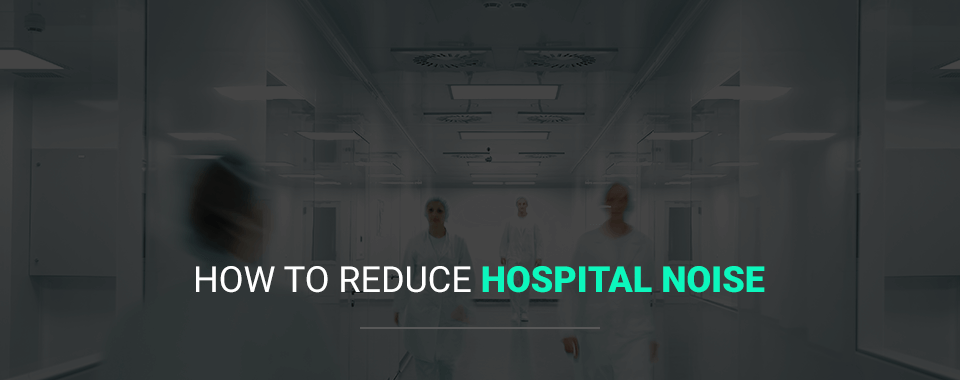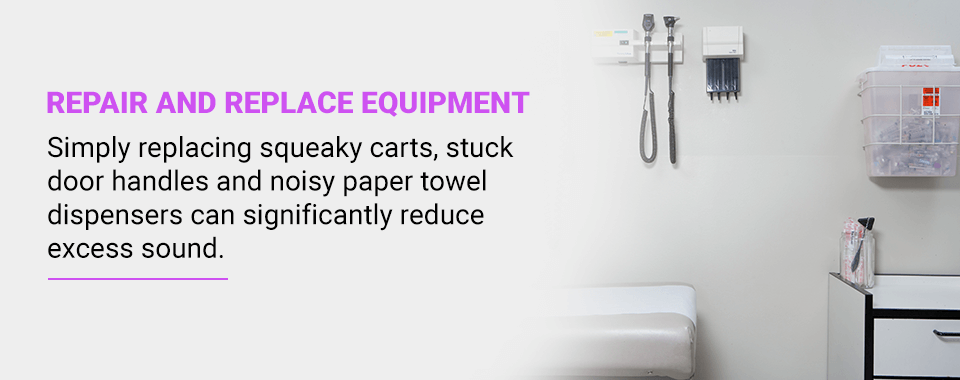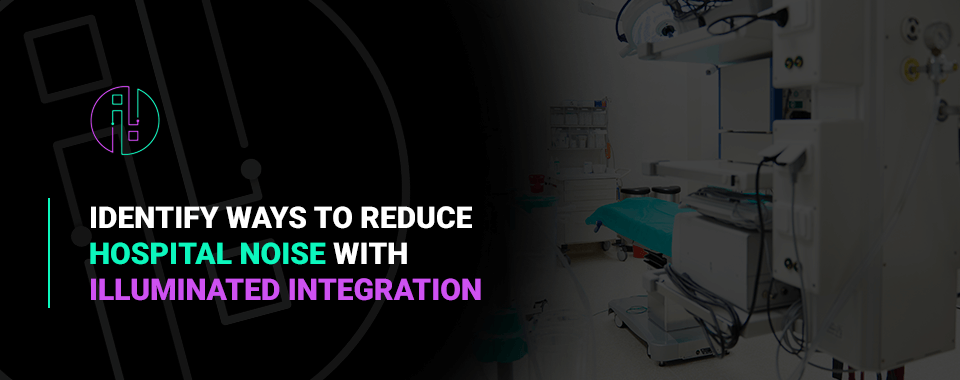

Patients in a hospital generally enjoy a quiet atmosphere to rest while they recuperate from their injury or illness. Yet, noise is a part of everyday life, even at inconvenient places and times. It can be challenging to reduce noise exposure in hospitals. Codes and emergencies sometimes create an unavoidable commotion, and medical equipment and conversations in the hallway create a constant buzz.
Most patients understand that many of these noises are inevitable. However, others are controllable and can even be eliminated. Excess noise can negatively impact patients in many ways. Implementing solutions for reducing noise in hospitals can help create a better recovery environment, leading to higher patient satisfaction.
Patients go to hospitals to heal from illness and injury, yet hospitals are sometimes anything but restful. The equipment and medical devices used in patient rooms often emit a constant, low-frequency noise that can be distracting. Patient-monitoring machines also produce jarring, high-frequency noises to alert hospital staff of a critical situation. These sounds, along with a persistent flow of staff members into and out of patient rooms, create a boisterous environment that makes relaxation challenging.
Considering noise exposure can optimize the quality of care and improve patient outcomes. Hospital noise can affect patients and employees alike in the following ways:
The World Health Organization (WHO) identifies several undesirable results of excessive noise in hospitals, including annoyance, sleep disturbance and fatigue. For patients in critical care units, a noisy environment could be one of their most significant stressors. Higher noise in hospitals often creates higher levels of patient dissatisfaction, as patients cannot get quality sleep and rest.
The WHO recommends that noise levels in hospitals stay below 35 decibels during the day. This acceptable noise level for hospitals is optimal for maintaining quiet. However, comprehensive studies have shown that noise in hospitals rarely meets care standards for safety and comfort. If hospitals use multiple strategies to reduce noise, they can enhance the patient experience and create a more restful environment.
Studies on patient outcomes have also indicated that excessive noise exposure negatively impacts recovery. Quality sleep is vital for patient recovery, as it can improve brain cell regeneration and decrease the likelihood of infection. Good sleep is especially critical for patients in the intensive care unit (ICU) who deal with critical health issues.
A lack of quality sleep in these patients can have negative consequences, including decreased energy levels and a slower recovery rate. Patients in the ICU are especially prone to the effects of poor sleep, like delirium and a weakened immune system. Providing patients with the best rest possible is paramount to a full recovery.
However, ICU patients often find it difficult to sleep uninterrupted because of ringing phones, conversations between hospital staff and frequent health assessments. Some studies reported the same or higher noise levels during the night as in the daytime. One study found that 30% of awakenings from sleep were due to environmental rather than physical factors. This level of disturbance is an opportunity for hospitals to give patients a better chance for a full recovery.
Hospital staff may be unaware of the impact that excessive noise has on them, yet they also experience the effects of sound exposure during working hours. According to the Occupational Safety and Health Administration, loud noises in the workplace can contribute to psychological stress, reduce productivity and inhibit effective communication. Constant ringing and unexpected alarms can increase blood pressure and stress among nurses and clinicians alike.
Working in a state of perpetual readiness for an emergency may be unavoidable in a hospital setting. Yet, there are ways to decrease the volume and frequency of alarms to avoid constant exposure to sound. Creating a quieter environment may help the healthcare providers at your hospital make quick decisions contributing to a better quality of care.
Hospital patients may hear noise from both people and machines. These noises may be continuous and low-frequency or loud and infrequent, like an alarm from a patient-monitoring device. Hospital managers must distinguish between the inevitable and preventable noises before working on reducing noise around patients. These steps to reducing hospital noise can help your staff develop a plan for creating a more restful environment.
Before you can reduce the noise affecting patients, you must identify its source. There may be multiple sources, and some will be impossible to stop. However, other noise sources may be unnecessary or louder than is essential.
To determine these noise generators and create solutions for your patients, form a committee to address sound in the hospital. This committee could include executives, administrators and other staff who deal with regular noise and can identify it quickly.
Conduct a noise analysis of your hospital to determine opportunities to reduce noise. Gather information from patients and healthcare providers through surveys asking them about the noise level. Since surveys may sometimes be biased, you can also install sound monitors in key locations throughout the hospital floors to pick up noise and register its volume in decibels. Sound monitors can be placed in patients’ rooms, hallways and nurses’ desks. After you identify the worst sources of noise, you can develop policies for noise reduction.

One of the noise sources that hospitals often think is unavoidable is the medical equipment in use. For example, today’s hospitals use a system of machine alarms to alert nurses and other staff when a patient experiences a medical emergency. Those alarms are necessary to provide efficient care during emergencies.
Some noise that machines cause is easy to ignore and can become background noise for patients. Equipment like ventilators, hemodialysis machines and respiratory machines emit low-frequency noise throughout the day and night. However, there may be instances in which medical alarms are calibrated to be too sensitive, resulting in frequent false alarms. You may be able to reduce the frequency and intensity of medical alarms by changing their settings.
Depending on your resources, you may want to purchase equipment optimized for sound reduction. Before taking that step, make sure equipment is properly maintained and repaired. Send in repair requests on time to get equipment working properly again. Simply replacing squeaky carts, stuck door handles and noisy paper towel dispensers can significantly reduce excess sound.
Televisions are one of the most common causes of noise pollution in hospitals. Many hospitals have TVs in patients’ rooms, hallways and waiting areas. The combined noise from multiple ongoing TV programs adds clatter that administrators could easily eliminate.
If closed captioning is not available on the TVs in common areas, administrators could keep the volume at a lower level or turn them off during certain times of the day or when no one is watching them. Administrators could also ask patients to use headsets with their TVs during the day, especially if their door is frequently open when nurses perform health assessments. They could also use TV sets with the speaker installed close to the patient.
Hospitals could also provide a white noise channel on all patient TVs and waiting areas. The channel could feature nature sounds and soothing images or videos to help patients relax. In addition, white noise machines located throughout the unit could help cover some of the other noises occurring on the floor.

With the prevalence of cell phone use in society, cell phones often accompany patients and visitors alike wherever they go to a hospital. Patients and family members need to use their phones to update others on health progress and make other arrangements, while healthcare providers need their phones to communicate with one another.
Excessive cell phone use can cause a distraction if it is unregulated. One of the best ways to reduce hospital noise is to designate cell phone zones in more populated areas with higher ceilings, where noise can dissipate instead of traveling directly into patient rooms. Posted signs can indicate the cell phone zones and remind staff and visitors that cell phone use is disturbing to patients. That way, you can keep hallway phone conversations to a minimum, especially at night.
Many hospitals also use overhead intercom systems, yet these systems broadcast information unnecessarily and can cause a significant interruption in patients’ rest. Replace overhead paging systems with wireless headsets or personal pagers so staff can communicate efficiently at a lower volume. Ensure that healthcare providers keep their pagers at low volume or vibrate.
Some aspects of coordinating patient care might help reduce noise levels in hospitals. For example, a designated quiet time might be helpful in which nurses perform no room checks unless medically necessary. It can be beneficial to dim hallway lights and limit movement on the hospital floor during these hours.
Frequently remind staff to keep their voices down during periods when patients are usually resting. Post signs warning staff and visitors to use normal speaking tones and emphasize the hospital’s commitment to reducing noise. Advise staff to speak with one another in close proximity rather than down the hallway.
Once they’ve identified the sources of noise at your hospital, the noise reduction committee can identify possible solutions. The solutions outlined above, combined with a few strategies below, can help your hospital reduce noise:
When implementing solutions, commit to a long-term program to reduce noise levels within the hospital. Of course, you also want to make patients feel more comfortable, but patient surveys can be ineffective to measure noise disruption in your facility objectively. For a transformative hospital environment, creating a noise-reduction program that lowers the average decibel level in different locations in the hospital is a valuable solution.

Solutions can be relatively simple and still make a difference in the amount of noise at the hospital. Even small changes in noise exposure can significantly impact patient results.
These strategies for improving the hospital environment should be ongoing rather than one-time fixes. Continuous monitoring is essential to determine if solutions are practical and other steps are needed. When the administration is open to new possibilities for improvement, they can continue improving satisfaction levels for patients and staff alike.
As you begin to see changes in noise levels and patient satisfaction, continue seeking feedback from patients, employees and visitors. Surveys are one way to gauge if people are still noticing the noise. Patients and visitors may be eager to communicate through follow-up surveys.
Reducing excessive noise in hospitals can significantly benefit patients with serious illnesses. From increased blood pressure to a weakened immune system, the consequences of poor rest are highly detrimental. Sleep is imperative to physical recovery, and providing a calm environment for sleep is part of a hospital’s work to promote healing for its patients.
If you need audio solutions to continual hospital noise, Illuminated Integration offers turnkey audio, video and lighting (AVL) solutions to control and reduce noise in your facility. We customize our design-build installations for every client, so you can be sure that your acoustics meet your patients’ needs. From idea to installation, Illuminated Integration will be with you at every step to help create a soundproof medical facility to improve patient care.
If you need a high-quality acoustics product for your hospital, our acoustics consultants can help you design a solution that meets your budget. Sound-absorbing and diffusing solutions can create a more calming hospital environment. You’ll also receive training and responsive maintenance support, so you can keep your AVL solutions working efficiently. Contact Illuminated Integration today to get started.
